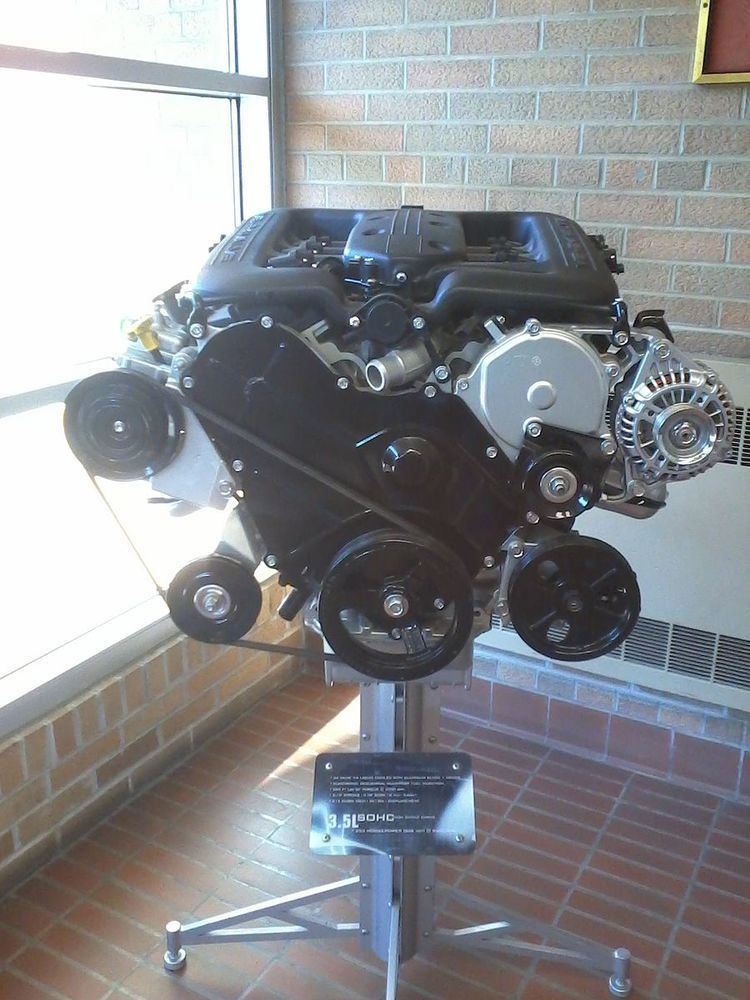Production 1993-2010 | Configuration 60° V6 | |
 | ||
Manufacturer Chrysler Corporation (1993-1998)DaimlerChrysler AG (1998–2007)Chrysler LLC (2007–2009)Chrysler Group LLC (2009-2010) Displacement 3,231 cc (197.2 cu in)3,518 cc (214.7 cu in)3,952 cc (241.2 cu in) Cylinder bore 92.0 mm (3.62 in)96.0 mm (3.78 in) Piston stroke 81.0 mm (3.19 in)91.0 mm (3.58 in) | ||
The single overhead cam V6 introduced in 1993 was a major advancement for Chrysler. It was derived from Chrysler's first homegrown front-wheel drive V6, the Chrysler 3.3 engine. The SOHC V6 has been replaced by the Chrysler Pentastar engine.
Contents
There are three major variants of this basic design: the 3.5 L, 3.2 L, and 4.0 L. Additionally, a 2.7 L DOHC version was derived.
History
A single overhead camshaft was a major addition to the lineup for 1993. Introduced with the 3.5 L engine, this basic design spawned 3.2 L and new 4.0 L variants as well as the DOHC 2.7 L Chrysler LH engine. All but the 2.7 and high-output 3.5 were produced at Trenton Engine in Trenton, Michigan.
The SOHC engine used an engine block that was very similar to its pushrod ancestors. But the front of the block was modified for the camshaft drive, and the heads were entirely different. One major change was that the SOHC engine was originally designed for the longitudinal placement of the Chrysler LH platform, rather than the transverse engine design of the K-cars and minivans. Since the bottom end was the same, the engine could be produced on the same assembly line in Trenton as the pushrod engine.
1993–97 3.5 L engines are a non-interference engine meaning that the valves will not collide with the pistons in the event of a timing belt failure. The 1998–2001 3.2 L, the 1998–2010 3.5 L, and the 2007–2011 4.0 L engines are interference designs.
3.5
This 3,518 cc (3.518 L; 214.7 cu in) engine was a version of the 3.3 but with a larger bore of 96 mm and the important addition of overhead cams. The 3.5L version has an intake arrangement with two separate manifolds and throttle bodies connected with a crossover valve. This provides better low and midrange torque. The four valves per cylinder are driven by a single overhead camshaft as opposed to the conventional DOHC arrangement for multivalve engines. Another difference with the 3.5 as opposed to the 3.3 is that it has a timing belt, not a timing chain. The water pump is also driven by the timing belt on the 3.5, whereas on the 3.3, the accessory belt drives it.
At its debut in 1993, this engine produced 214 hp (160 kW) and 221 lb·ft (300 Nm) from an iron block and aluminium cylinder heads. The 3.5 L engine was redone entirely of aluminum in 1999 as the EGG high output, producing 247–253 hp (190 kW) at 6500 rpm with 250 lb·ft (339 Nm) of torque at 4000 rpm. Output from 2002–2004 for the standard output EGJ is 234 hp (174 kW) at 6000 rpm with 241 lb·ft (327 Nm) of torque at 4400 rpm. Also for 2002–2004, the EGK 3.5 L Special was built exclusively for the 300M Special, producing 255 hp and 258 lb·ft.
The EGJ was built in Trenton, MI. The EGG was built in Kenosha, WI. The EGK was discontinued in 2004.
The 3.5 L version is no longer in production as of 2011, replaced by the newer Pentastar 3.6 V6
Vehicles using the 3.5 include:
3.2
The 3.2 L version came along with the updated LH platform in 1998. It was an SOHC 4-valve design displacing 3,231 cc (3.231 L; 197.2 cu in) with a smaller 92 mm (3.6 in) bore but the same 81 mm (3.2 in) stroke as the 3.5. It produced 225 hp (168 kW) and 225 lb·ft (305 N·m) and met the TLEV standard. It was discontinued after the 2001 model year. Option code EGW.
Applications:
4.0
The 3.5 L engine was expanded to 3,952 cc (3.952 L; 241.2 cu in) for the 2007 Dodge Nitro and Chrysler Pacifica. Like its family members, this is a SOHC engine and is built in Trenton, Michigan. DaimlerChrysler reportedly spent $155 million to expand the Trenton plant to manufacture this engine. Option code EGQ for front wheel drive applications, EGS for rear wheel drive applications.
Applications:
DOHC
The DOHC 2.7 L Chrysler LH engine is based on this same design, though the bore, stroke, and production site are different.
